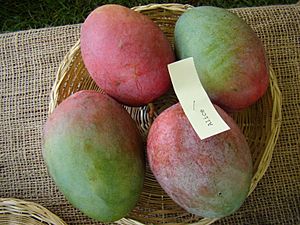Alice (mango) facts for kids
Quick facts for kids Mangifera 'Alice' |
|
|---|---|
| Genus | Mangifera |
| Species | Mangifera indica |
| Hybrid parentage | 'Saigon' seedling |
| Cultivar | 'Alice' |
| Origin | Florida, US |

The Alice mango is a special type of mango that first grew in south Florida. It's known for its sweet taste and smooth flesh.
The Story of the 'Alice' Mango
The very first 'Alice' mango tree started from a seed in 1935. It grew on the property of Fred Herman in South Miami, Florida. He named this new mango after his wife, Alice Herman.
Some people think the 'Alice' mango might be a mix. It could be a cross between the 'Saigon' mango and a type of mango from India. The tree first produced fruit in 1940. Its name became official in 1950.
Even though the 'Alice' mango tasted good, it wasn't grown much by farmers. This was because the trees didn't produce many mangoes consistently.
Today, you can find an 'Alice' mango tree in a special plant collection. This collection is kept by the USDA in Miami, Florida. Another 'Alice' tree is planted at the University of Florida's Tropical Research and Education Center in Homestead, Florida. These trees help scientists study and preserve different mango types.
What Does an 'Alice' Mango Look Like?
The 'Alice' mango fruit is usually oval-shaped. It weighs less than a pound when it's ready to eat. The skin is smooth and turns yellow-orange when ripe. Sometimes it has a bit of a red blush.
The top of the fruit is round and doesn't have a pointed tip. The inside of the mango smells strong and pleasant. It has a rich, sweet taste and no stringy fibers. This mango has a single seed, which means it's monoembryonic. In Florida, 'Alice' mangoes are usually ready to pick from late June to July.
The 'Alice' mango tree grows strongly. It has branches that spread out wide, forming a large canopy.

